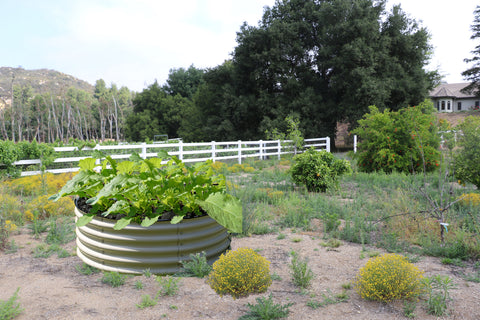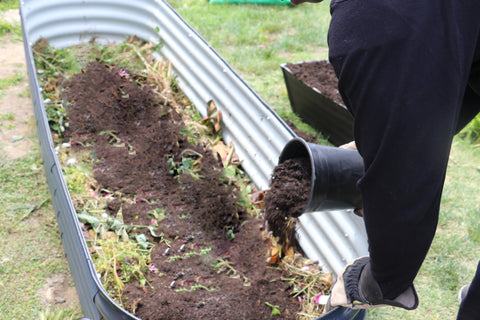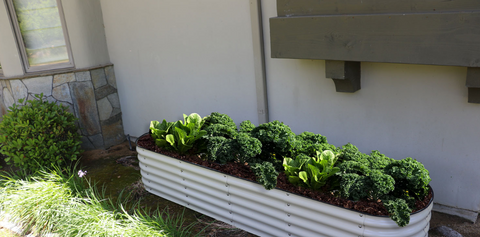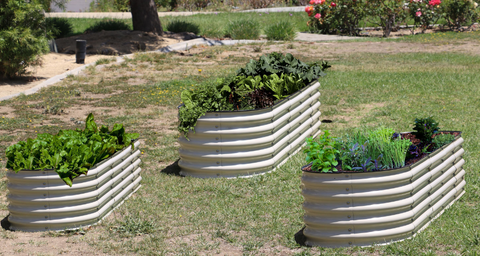Knowledge from Olle Garden Bed: Does The Seed Need Light Or Not?
Most people who have a beginner's knowledge of plant growth accept that seeds need light to germinate. If you start sowing indoors, you know it is necessary to grow a lamp where there is no sunlight. But do you know some seeds and plants do not need light to germinate? The following content also has some reference value for raised garden beds.
The basic needs for growth are light, water and soil. These three factors contribute to photosynthesis. The degree of these basic elements is necessary, but sometimes sunlight or light, generally speaking, does not need to germinate seeds. Sometimes sunlight suppresses seeds that germinate in the dark.
Some seeds do not need light to break through their shells and germinate. Most seeds germinate best when a controlled amount of ultraviolet light is produced, but some seeds germinate without light.
In addition, some plants can get enough light in the high shade area of the garden even in the dark.
What do seeds need to germinate?
Germination occurs when dormant seeds revive through interaction with water, oxygen, light and soil content. Let's introduce the basics of seed germination by examining the necessary components involved.

moisture
Seeds themselves contain a small amount of water, but they need to be planted in moist soil to recover from dormancy. The extra water starts a process called absorption. At this stage, the seed is filled with water, and the enzymes in it are activated, which help to pressurize the seed's shell and help the seedlings emerge from the soil surface.
It is important to properly balance the moisture content in the soil so that sowing can begin. Each seed has different requirements. For example, quinoa requires very little water and shallow soil cover to germinate. Therefore, the soil should be kept dry for some time before the seedlings develop. Too much water will rot quinoa seeds.
Seeds such as trollius or sunflower have a thick seed coat, which requires a lot of water to break through. In this case, too little water will either completely prevent germination, or cause seedlings to die when shooting. Usually, these are pre soaked to ensure that they germinate.

oxygen
The seed needs oxygen and a suitable airflow to generate enough energy to bounce back from the dormancy. This is because glucose contributes to the aerobic respiration process. At this stage, seeds release energy from food storage, and they need oxygen to do this.
Without enough oxygen, the seed cannot offset enough water and carbon dioxide to produce the energy needed for growth.
So, how do we ensure that the seeds have enough oxygen? Understanding the planting depth of seeds is a way for us to help them germinate. In most cases, seeds are planted under a thin layer of moist soil.
Planting seeds such as amaranth or mugwort too deep will make the seedlings unable to obtain the oxygen needed to absorb, thus preventing the seeds from entering the food storage needed for germination. This is because the seed coat is very thin.
Some thin skinned seeds do not even need to be covered with soil and can be spread on a thin layer of soil surface. However, some seeds have thicker fur and germinate best when scars are formed, or when the seed shell is scratched or streaked. The stripe process allows seeds with thick fur to enter the gas, such as oxygen, needed to use food to store energy.

There are many arguments among gardeners about planting depth. Usually the seed package says to be planted in 25 inches deep, but it may be too deep for some seeds. In terms of planting depth, the general rule of thumb is never to plant a seed that is more than twice its diameter and depth.
As mentioned above, smaller seeds with thinner seed coats may not even need to be covered. Another way to ensure proper oxygen flow is to avoid compressing the soil. Instead, let the seedlings come out of the lightly tapped soil.
temperature
Although many people say that seeds need light to germinate, they really mean that seeds need proper temperature to germinate. The germination rate is an important factor here. If the seed has a high germination rate, temperature control may not be necessary.
For seeds with low germination rate, gardeners must plant more seeds to obtain considerable yield. In this case, it is better to try to set the correct temperature conditions in advance to avoid wasting seeds.
Sometimes, sowing at the right time and in the right season is the best way to ensure that the temperature conditions are suitable for germination. Some seeds like the heat in spring or summer, and some varieties like the cool conditions in autumn. Some even need to be planted in autumn to be exposed to cold stratification throughout the winter to promote spring germination.

Other times, it is necessary to start indoors and use the tray with heating pad below to start the seeds that do not need to be sown directly. The seed starting pad can increase the heat of the seed tray by 10 degrees. Therefore, in this case, a greenhouse or room with a base temperature of 65 degrees Fahrenheit will work.
Seeds that need to be set at a temperature to germinate before planting a garden can meet their needs only when they are planted at the correct depth and have sufficient moisture conditions.
Sometimes, if the seeds are exposed to the right amount of seeds, light can provide enough heat. But in this process, the seeds sown in shallow layers may be killed.
It's better to keep up with the requirements of seed germination and see how critical you need to be in the process of germination.
Now for the light!
Interestingly, most commercial seeds germinate with or without light because they are selected outside a set of required conditions. However, some need to be exposed to light. More about specific seeds that require light or do not require light to germinate.
For nearly a hundred years, scientists have been studying the light requirements for germination. Through experiments on different heat and light control, Kinzel (1926) learned that some seeds need light and some seeds need darkness to germinate.
Those who need light sometimes do not need to be covered with soil. This allows the seed to obtain light that properly supports the germination process. Those who need dark germination may need to plant deeper plants in the soil to block ultraviolet rays that may prevent germination.

Is light necessary?
The fact is that all seedlings need light to take root. Without it, when they try to find a light source, their legs will become tight. The amount of light required for each seedling varies from plant to plant.
Those who need less light in adulthood do not need as many as those who enjoy full sunlight throughout their life cycle. Seedlings exposed to excessive light or heat will wither and die.
But when it comes to seeds, some need light to germinate, while others don't. It is important to understand this when deciding whether to start sowing indoors or outdoors. Let's take a moment to look at photosynthesis and study why some seeds germinate under light, while others do not.
Plant photoreceptor
The key to understanding which seeds need light to germinate and which seeds need darkness is plant pigments. Plant pigments are light receptors in plants, which help photosynthesis by interacting with red ultraviolet light.
There are two types of plant pigments in the plant world: Type I is activated by far red ultraviolet light, and Type II is activated by red ultraviolet light.
For example, trees in the canopy of tropical rainforests can withstand direct sunlight or red light due to their type II plant pigments. When this light is absorbed, the leaves of crown trees will not only reflect back the light they absorb, but also reflect back the far red light below the forest ground plants. These plants at the bottom of the forest contain type I plant pigments. If they receive red light instead of far red light, they will often be burnt.
Therefore, when it comes to plants with leaves, the answer to this question is always yes. Light is necessary, but the type of light is very important here. Depending on the susceptibility of plants, such as herbs, the wrong light can cause damage. vice versa. Plants that receive the right light thrive when all other needs are met.
How much light is enough
If you are dealing with seeds that require light to germinate, you can activate them in a tray with a growth lamp or in a sunny south or north facing window (depending on the hemisphere you live in).
Alternatively, if the weather is warm enough and sunny enough, seeds can be sown directly in thin layers of soil. Greenhouses with direct sunlight in early spring can also provide enough light and heat for germination.

Seeds that do not require light to germinate should be sown in trays. To ensure they are not exposed to light, try covering them with black plastic. When covering, monitor the temperature to ensure that it remains within the proper germination range.
The plastic captures a lot of heat and keeps the soil moist, providing moisture for your tray.
Seeds that need light
Most vegetables need ultraviolet radiation to germinate, so we are not going to list them here. But here is a group of plants that usually grow from seeds. If there is no light, they will not germinate. All examples here are plants with tiny seeds that have thin seed shells.
Lettuce: Here is an example of a seed that can germinate in your garden without covering it with soil. Lettuce seeds must be exposed to light to grow into seedlings. You can spread them on the soil or vermiculite, and then cover them with a thin layer of soil or vermiculite.
Carrots: Just like lettuce, in order to let carrot seeds germinate, sprinkle them on the soil surface to expose them to the light. Use the same method as lettuce: plant seeds in rows on soil or vermiculite, and cover them with soil or vermiculite.
Rose: Rose seeds germinate best under direct sunlight. Keep the soil moisture at an appropriate level, and the seedlings will appear in about six weeks.
Some salvia miltiorrhiza: check the varieties here, because some salvia miltiorrhiza species prefer darkness. After sowing directly on the ground of the garden, keep the soil moist, but do not wash away the small seeds.
Like dark plants
As we introduced, several species prefer to exist in the dark. Many of them are popular garden varieties with thick seed shells and germinate well under dark cover deep in the soil.
Golden Lotus: There are many advantages to using Golden Lotus Garden Art. Sow directly the seeds of Trollius chinensis, whose diameter is about three times of its diameter, and cover them with rich organic soil. Soon, you will have happy round leaf seedlings!
Calendula: The sun inhibits the growth of Calendula. Cover the wormlike seeds in 1 inch of organic soil to avoid direct sunlight. Keep the soil moist when using Calendula Garden.

Sunflower: The planting depth of mammoth species is three times of its diameter, and it is better to conduct under the plastic cover before germination. Once the first sign of germination occurs, remove the plastic cover and transfer the seedlings to direct light.
Onion: Allium seeds are very large, their shells are thick, and they will not germinate under direct light. They actually prefer to spend long nights during germination. Therefore, you can start them indoors with plastic, then take out the plastic and expose them to light after they germinate.
Seeds that don't really care
The following plants will germinate with or without light. Their seed size is often between the above large categories and small categories.
Tomatoes: Start indoors or outdoors under appropriate temperature conditions. In some places, tomato crops will grow until the middle of autumn.
Cucumber: Personally, I can't prevent cucumber seeds from germinating. They germinate under almost any conditions involving soil. If you are looking for high germination rate, please save the seeds of your favorite cucumber varieties. One thing to remember about cucumbers is to omit vermiculite at the beginning of the seed.
Eggplant: Although eggplant seed does not need light to germinate, it will not be injured.
Zinnia: Zinnias needs to be directly sown in sunny places under light soil cover. If you have ever tried to transplant zinnia seedlings, you will know that they will be impacted by transplantation, so please avoid starting indoors. They are the perfect companion for your tomato and lettuce crops.
If you find yourself overwhelmed by all these different factors, start small. Plant several different types of seeds and track their needs. Follow your progress! You will learn what is best for you and which methods will not work over time.
